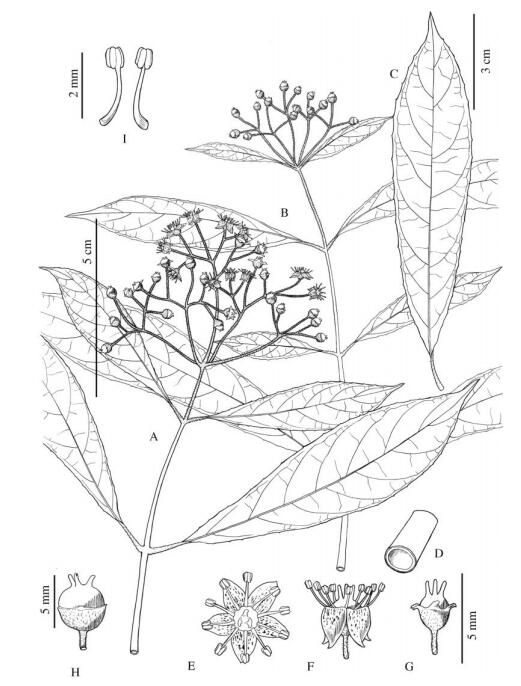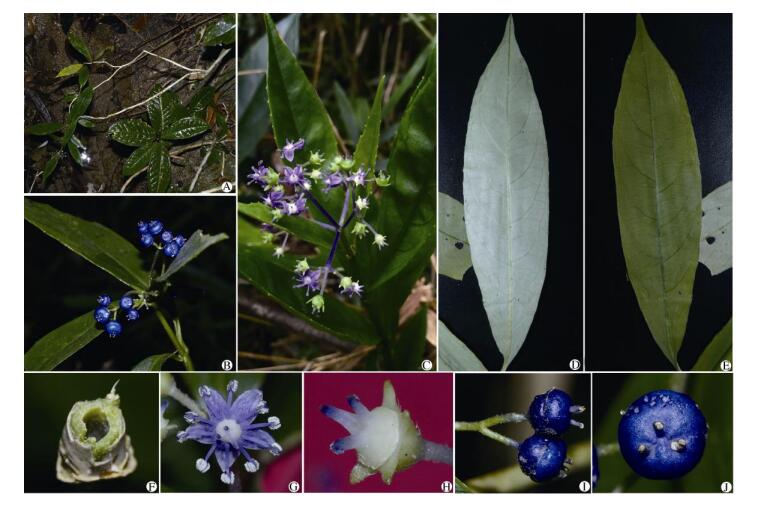2. 苏州出入境检验检疫局, 江苏 苏州 215021
2. Suzhou Entry-Exit Inspection and Quarantine Bureau, Suzhou 215021, Jiangsu, China
Dichroa Lour. of tribe Hydrangeae (Hydran geaceae), comprising about 12 species, is mainly distributed in mainland Southeast Asia and the adjacent islands, with 6 species occur in China[1-3]. Some species of this genus have ornamental values in garden. However, except for the widely distributed species of D. febrifuga Lour., this group of plants have been poorly collected, and a taxonomic revision is thus needed.
Tentatively Dichroa was divided into two sections by the number of stamens, sect. Dichroa and sect. Silvicola S. M. Huang. Sect. Dichroa was further split into two series based on the characteristics of the ovary, ser. Dichroa and ser. Mollissimae S. M. Huang[1, 4].
In June 2016 and January 2017, the first two authors found an unusual population of Hydran geaceae in Yangchun City, Guangdong Province. The inflorescence of this species only contains fertile flowers, and the fruits are blue berries, which suggest its affiliation of genus Dichroa. The flower of the species contains 10 stamens and semi-inferior ovaries, which show the characteristics of ser. Mollissimae of sect. Dichroa. The plants are here described as a new species, Dichroa fistulosa G. H. Huang & G. Hao.
The morphological description of the new species was based on careful examination of the type specimens. The comparison between it and the morphologically related species (D. febrifuga, D. mollissima Merr., D. philippinensis Schltr., Hydrangea kwangsiensis Hu and H. stenophylla Merr. et Chun) was performed on studies of the herbarium materials in IBSC.
Dichroa fistulosa G. H. Huang & G. Hao, sp. nov. Figures 1 and 2.

|
Fig. 1 Dichroa fistulosa. A: Flowering branchlet; B: Branchlet with young fruit; C: Leaf; D: Transverse plane of the stem; E: Frontal plane of the flower; F: Profile plane of flower; G: Flower without petals and stamens; H: Berry; I: Stamens. (Drawn by Li-hua Liu from the holotype) |

|
Fig. 2 Dichroa fistulosa. A: Habit, showing white stems; B: Fruiting branchlet; C: Flowering branchlet; D: Leaf abaxially; E: Leaf adaxially; F: Transverse plane of stem; G: Frontal plane of flower; H: Flower without petals and stamens; I: Profile plane of berries; J: Frontal plane of berry. (Photographed by Ge-han Huang) |
Type: China, Guangdong, Yangchun City, Bajia Town, Ehuangzhang Nature Reserve, alt. 609 m, June 14, 2016, G. H. Huang 160091 (holotype, IBSC; isotype, CANT).
Diagnosis: Dichroa fistulosa is similar to D. mollissima, but differs by its glabrous or sub-glabrous leaf blade. It is also similar to D. philippinensis, but the shape and serration of leaves are different.
Shrubs 0.5-2 m tall. Stem erect or sub-scandent, fistular. Branchlets green in first year, become white in the second year, glabrous, bark peeled off when old. Leaves opposite, petiole 0.8-2 cm, sparsely pubescent; leaf blade narrowly elliptic to lanceolate or oblanceolate, 6-20 cm×1.5-5 cm, papery, glabroussadaxially, glabrous or sub-glabrous abaxially; secondary veins 5-8 on each side of midvein, base cuneate, margin sparsely serrate distally from middle, apex acuminate to caudate. Inflorescence a corymbose cyme, 3-6 cm×2-5 cm, with 10-30 flowers; peduncle 1-4 cm, sparsely pubescent; pedicel 3-5 mm, sparsely pubescent. Calyx tube cupular, ca. 1.5 mm, pubescent; lobes 5, ovate, 0.7-1.2 mm, glabrous, apex acute to acuminate. Petals purple or deep blue, with deep purple spot, ovate, ca. 2.5 mm, glabrous, apex acute. Stamens 10; filaments filiform, 2-2.5 mm; anthers ovoid-ellipsoid. Ovary semi-inferior. Styles 3(-4), robust, 1-1.5 mm; stigma small. Berry blue, subglobose, ca. 6 mm, pubescent or glabrous. Seeds ellipsoid. Flowering from May to June, fruiting from December to January.
Distribution and habitat: Dichroa fistulosa is presently known from the central and western Guangdong Province, e.g., Yangchun, Zhaoqing, Jiangmen and Huidong Cities. It grows at wet area under forests or by roadsides, at altitude of 400-700 m.
Etymology: The epithet fistulosa refers to the hollow, pipe-like stems of the new species.
Additional specimens examined (paratypes): China. Guangdong: Yangchun City, Bajia Town, Ehuangzhang Nature Reserve, alt. 620 m, Jan. 12, 2017, G. H. Huang & X. K. Yan 170001 (IBSC, CANT); Yangchun City, Bajia Town, alt. 650 m, Aug. 1, 2001, H. G. Ye 6132 (IBSC); Zhaoqing City, Dinghu Mountain, Aug. 31, 1978, G. L. Shi 13691 (IBSC); Jiangmen City, Xinhui District, Gudou Mountain, May 29, 1985, Z. X. Li et al. 2386 (IBSC).
Taxonomic remarks: In traditional angiosperm classification systems[5-6], Tribe Hydrangeeae of Hydrangeaceae includes 9 morphologically diverse genera, i.e., Hydrangea L., Deinanthe Maxim., Cardiandra Sieb. & Zucc., Dichroa, Broussaisia Gaudich., Schizophragma Sieb. & Zucc., Pileostegia Hook. f. & Thoms., Decumaria L., and Platycrater Sieb. & Zucc. Recent molecular phylogenetics[7-9] revealed that eight of those genera are phylogenetically nested within Hydrangea, rendering the latter highly polyphyletic. A broader circumscription of the genus Hydrangea was therefore proposed[8], to comprise all eight satellite genera of the tribe. Genus Dichroa was consequently reduced to a section, sect. Dichroa, of Hydrangea. On the other side, Ohba and Akiyama[10] argued to rescue the traditional genera delimited by Engler[5] since it was easy to distinguish these genera by their morphological features, habit ecological preferences. So generic segregation of most of the sections and subsections of Hydrangea by Engler[5] was again proposed[10], according to the tree by De Smet et al.[9].
Considering the monophyly and its easily recognizable attributes of Dichora differing from Hydrangea and other genera, the proposal of Granados et al.[8] is regarded not consummate enough, alternative treatment might be expected. We thus echo Ohba and Akiyama[10] and maintain the definition of genus Dichroa temporarily.
In Dichroa, D. fistulosa is allied to D. mollissima, but is distinguished easily by its glabrous or subglabrous leaf blade. It also resembles D. philippinensis, but the shape and the serration of leaves are quite different. Additionally, its hollow stem is distinct from all other Dichroa species. Dichroa fistulosa and its allies can be distinguished from one another by the following key.
Key to Dichroa fistulosa and similar species
1. Ovary inferior to 3/4; styles 4-6············································································ D. febrifuga
Ovary semi-inferior; styles (2-)3(-4)············································································ 2
2. Leaf blade densely pubescent on both surfaces or abaxially················································ 3
Leaf blade glabrous or sub-glabrous on both surfaces············································································· 4
3. Leaf blade densely villous abaxially, glabrous adaxially··············································· D. mollissima
Leaf blade crisped pubescent on both surfaces·················································· D. yunnanensis
4. Leaf shape elliptic to oblong, length 2-3 times the width, margin densely serrate above middle·························· D. philippinensis
Leaf shape narrowly elliptic to lanceolate or oblanceolate, length 4-5 times the width, margin sparsely serrate above middle
······································································· D. fistulosa
The plants without fruits of the new species are similar to some species of genus Hydrangea superficially, such as H. kwangsiensis or H. stenophylla, but the fleshy blue berries and the inflorescence without sterile flowers show the marked distinction between those two genera. Some paratypes of the new species, e.g., H. G. Ye 6132 (IBSC), G. L. Shi 13691 (IBSC) and Z. X. Li et al. 2386 (IBSC) were formerly misidentified as H. kwangsiensis.
| [1] | HUANG S M. A preliminary study on Dichroa Lour.[J]. Acta Phytotax Sin, 1987, 25(5): 384-289. |
| [2] | HUANG S M. Bartholomew B. Dichroa[M]//Flora of China, Vol. 8. Beijing: Science Press & St. Louis: Missouri Botanical Garden Press, 2001: 404-406. |
| [3] | HUFFORD L. Hydrangeaceae[M]//The Families and Genera of Vascular Plants, Vol. 6. Heidelberg: Springer, 2004: 202-215. |
| [4] | HUANG S M.Dichroa[M]//Flora Reipublicae Popularis Sinicae, Tomus 35(1).Beijing:Science Press, 1995:177-184.(in Chinese) |
| [5] | ENGLER A. Trib. Xll. 2. Hydrangeoideae-Hydrangeeae[M]//Die Naturlichen Pflanzenfamilien. 12th ed, Leipzig: Wilhelm Engelmann, 1930, 18a: 200-210. |
| [6] | CRONQUIST A. An Integrated System of Classification of Flowering Plants[M]. New York: Columbia University Press, 1981: 555-557. |
| [7] | SAMAIN M S, WANKE S, GOETGHEBEUR P. Unraveling extensive paraphyly in the genus Hydrangea s.l.with implications for the systematics of tribe Hydrangeeae[J]. Syst Bot, 2010, 35(3): 593-600. DOI:10.2307/40802553 |
| [8] | GRANADOS M C, WANKE S, SALOMO K, et al. Application of the phylogenetic informativeness method to chloroplast markers:A test case of closely related species in tribe Hydrangeeae (Hydrangeaceae)[J]. Mol Phylogen Evol, 2013, 66(1): 233-242. DOI:10.1016/j.ympev.2012.09.029 |
| [9] | de SMET Y, GRANADOS M C, WANKE S, et al. Molecular phylo-genetics and new (infra) generic classification to alleviate polyphyly in tribe Hydrangeeae (Cornales:Hydrangeaceae)[J]. Taxon, 2015, 64(4): 741-753. DOI:10.12705/644.6 |
| [10] | OHBA H, AKIYAMA S. Generic segregation of some sections and subsections of the genus Hydrangea (Hydrangeaceae)[J]. J Jap Bot, 2016, 91(6): 345-350. |
 2018, Vol. 26
2018, Vol. 26


